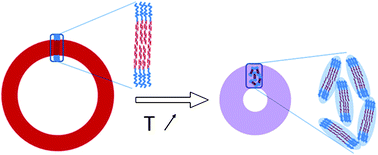Structural changes in liquid crystal polymer vesicles induced by temperature variation and magnetic fields†
Abstract
The structural changes in liquid crystal (

* Corresponding authors
a
Institut Curie, Centre de Recherche, Paris, France
E-mail:
min-hui.li@curie.fr
Fax: +33-1-40510636
Tel: +33-1-56246763
b CNRS, UMR168, Physico-Chimie Curie, Paris, France
c UPMC Université Paris VI, Paris, France
d Laboratoire Léon Brillouin, UMR12 CEA-CNRS, CEA Saclay, Gif sur Yvette, France
e CNRS, UMR 7610, Chimie des Polymères, Paris, France
The structural changes in liquid crystal (

 Please wait while we load your content...
Something went wrong. Try again?
Please wait while we load your content...
Something went wrong. Try again?
S. Hocine, A. Brûlet, L. Jia, J. Yang, A. Di Cicco, L. Bouteiller and M. Li, Soft Matter, 2011, 7, 2613 DOI: 10.1039/C0SM00751J
To request permission to reproduce material from this article, please go to the Copyright Clearance Center request page.
If you are an author contributing to an RSC publication, you do not need to request permission provided correct acknowledgement is given.
If you are the author of this article, you do not need to request permission to reproduce figures and diagrams provided correct acknowledgement is given. If you want to reproduce the whole article in a third-party publication (excluding your thesis/dissertation for which permission is not required) please go to the Copyright Clearance Center request page.
Read more about how to correctly acknowledge RSC content.
 Fetching data from CrossRef.
Fetching data from CrossRef.
This may take some time to load.
Loading related content
